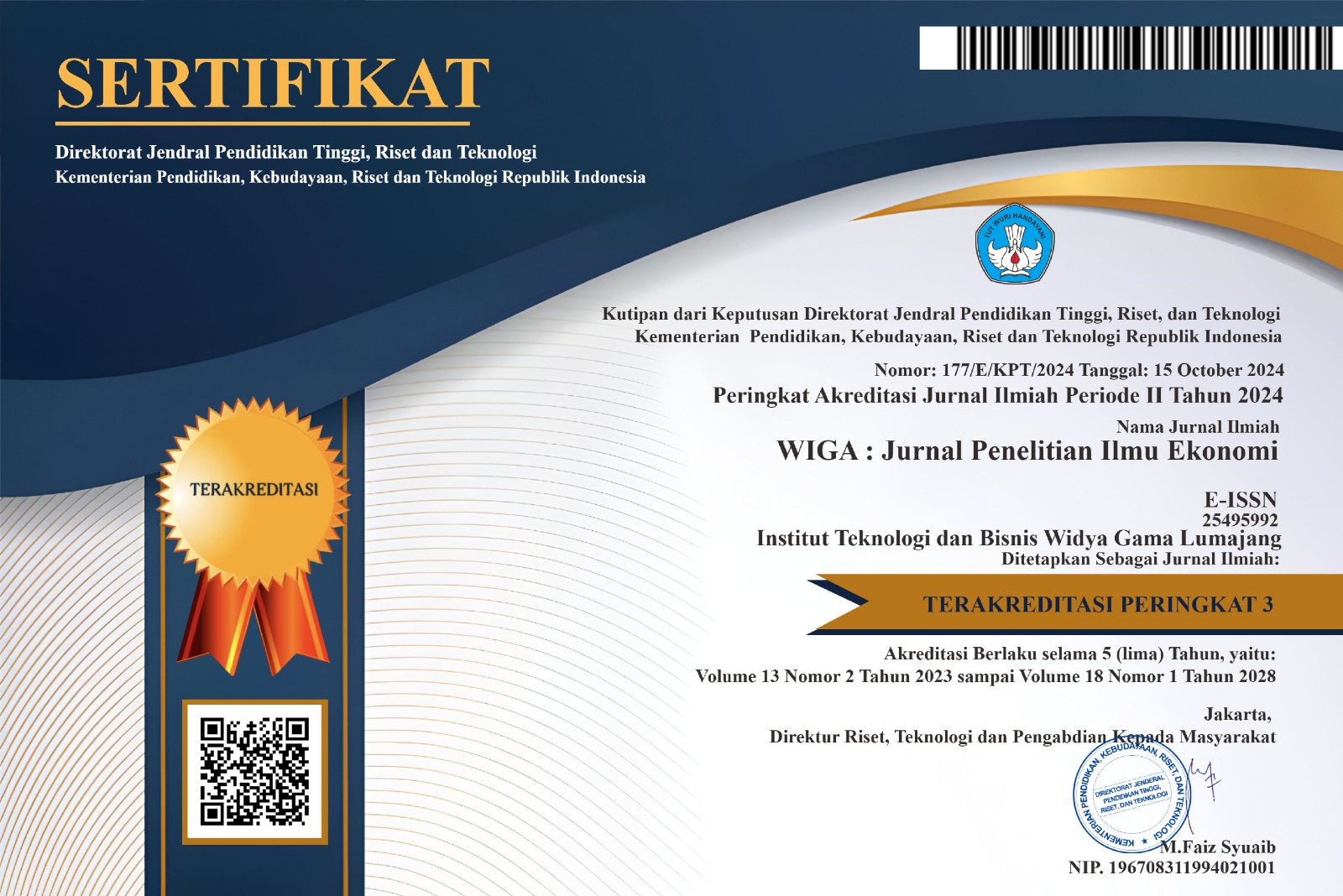Stock Price Volatility: An Efficiency Test of The Indonesian Stock Exchange In Semi-Strong Form
DOI:
https://doi.org/10.30741/wiga.v14i2.1307Keywords:
Market Efficiency, Semi-Strong Form, Factor Analysis, Multiple RegressionAbstract
An efficient capital market is a concept in which stock prices reflect all available public information. However, the level of market efficiency varies in different countries, including Indonesia. This study aims to test semi-strong market efficiency on the Indonesia Stock Exchange (IDX) by analyzing the effect of financial and macroeconomic variables on stock prices. The study population includes all companies listed on the IDX in the 2018-2022 period. The sample was selected using purposive sampling method based on certain criteria namely issuers belonging to the primary and non-primary consumer goods sector, with a total of 174 issuers. Independent variables in this study include CR, DER, ROE, PER, Firm Size, DPR, CSR, inflation, exchange rate, and BI Rate. The dependent variable is stock price. The factor analysis method was used to reduce the independent variables into three factors: financial efficiency, corporate dimensions, and corporate external factors. Multiple regression analysis was then applied to test the effect of these three factors on stock prices. The results showed that financial efficiency factors and external factors did not have a significant influence on stock prices. However, the firm dimension factor is proven to have a significant influence on stock prices.
Downloads
References
Ariyani, V. (2017). Pengujian Efisiensi Pasar Setengah Kuat Terhadap Pengumuman Paket Kebijakan Ekonomi Vii Pada Saham Indeks Lq 45. Ekonika : Jurnal Ekonomi Universitas Kadiri, 2(1), 87–98. https://doi.org/10.30737/ekonika.v2i1.20
Dewi, L. P. K., & Artini, L. G. S. (2014). Pengujian Efisiensi Pasar Bentuk Setengah Kuat Di Bursa Efek Indonesia. E-Jurnal Manajemen Universitas Udayana, 3(12), 253083.
Gbanador, M. A. (2021). An Empirical Test for Semi-strong form Efficient Market Hypothesis of the Nigeria Stock Market. Asian Journal of Economics, Business and Accounting, 21(23), 42–53. https://doi.org/10.9734/ajeba/2021/v21i2330532
Junaid, M. T., Juliana, A., Marchella, J., & Muh, L. (2021). Studi Efisiensi Pasar Modal Indonesia Bentuk Setengah Kuat Pada Masa Pandemi Covid-19 (Perusahaan Transportasi Di Bursa Efek Indonesia Tahun 2019-2020). Jurnal Akuntansi Keuangan Dan Bisnis, 14(2), 201–210.
Kurniawati, S. L., & Lestari, W. (2011). Pengujian Efisiensi Bentuk Setengah Kuat Di Indonesia. Journal of Business and Banking, 1(1), 143. https://doi.org/10.14414/jbb.v1i2.247
Sulistiani, T. (2020). Pengujian Efisiensi Pasar Modal Syari’ah Bentuk Lemah dan Setengah Kuat di Bursa Efek Indonesia. KHOZANA: Journal of Islamic Economic and Banking, 3(2), 1–23. http://journal.stebisdarussalamoki.ac.id/index.php/khozana
Tjandra, R., Akuntansi, A., & Yogyakarta, Y. (2006). Pengujian Efisiensi Pasar Setengah Kuat Secara Informasi terhadap Pengumuman Inisiasi Dividen (Studi Empiris pada Perusahaan-Perusahaan yang Terdaftar di Bursa Efek Jakarta Periode Tahun 2000-2003). Jurnal Akuntansi Dan Investasi, 7(2), 175–194.
Downloads
Published
How to Cite
Issue
Section
License
Copyright (c) 2024 Muhammad Mukhsin, Hari Sukarno, Hadi Paramui

This work is licensed under a Creative Commons Attribution-NonCommercial 4.0 International License.










